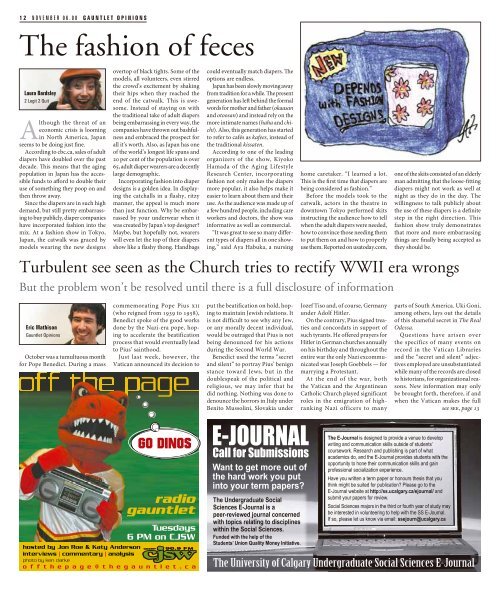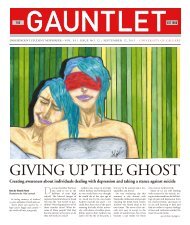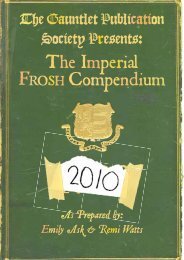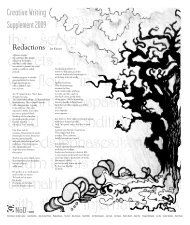Create successful ePaper yourself
Turn your PDF publications into a flip-book with our unique Google optimized e-Paper software.
12 NOVEMBER 06.08 GAUNTLET OPINIONS<br />
<strong>The</strong> fashion of feces<br />
Laura Bardsley<br />
2 Legit 2 Quit<br />
Although the threat of an<br />
economic crisis is looming<br />
in North America, Japan<br />
seems to be doing just fine.<br />
According to cbc.ca, sales of adult<br />
diapers have doubled over the past<br />
decade. This means that the aging<br />
population in Japan has the accessible<br />
funds to afford to double their<br />
use of something they poop on and<br />
then throw away.<br />
Since the diapers are in such high<br />
demand, but still pretty embarrassing<br />
to buy publicly, diaper companies<br />
have incorporated fashion into the<br />
mix. At a fashion show in Tokyo,<br />
Japan, the catwalk was graced by<br />
models wearing the new designs<br />
overtop of black tights. Some of the<br />
models, all volunteers, even stirred<br />
the crowd’s excitement by shaking<br />
their hips when they reached the<br />
end of the catwalk. This is awesome.<br />
Instead of staying on with<br />
the traditional take of adult diapers<br />
being embarrassing in every way, the<br />
companies have thrown out bashfulness<br />
and embraced the prospect for<br />
all it’s worth. Also, as Japan has one<br />
of the world’s longest life spans and<br />
20 per cent of the population is over<br />
65, adult diaper wearers are a decently<br />
large demographic.<br />
Incorporating fashion into diaper<br />
designs is a golden idea. In displaying<br />
the catchalls in a flashy, ritzy<br />
manner, the appeal is much more<br />
than just function. Why be embarrassed<br />
by your underwear when it<br />
was created by Japan’s top designer?<br />
Maybe, but hopefully not, wearers<br />
will even let the top of their diapers<br />
show like a flashy thong. Handbags<br />
could eventually match diapers. <strong>The</strong><br />
options are endless.<br />
Japan has been slowly moving away<br />
from tradition for a while. <strong>The</strong> present<br />
generation has left behind the formal<br />
words for mother and father (okaasan<br />
and otoosan) and instead rely on the<br />
more intimate names (haha and chichi).<br />
Also, this generation has started<br />
to refer to cafés as kafees, instead of<br />
the traditional kissaten.<br />
According to one of the leading<br />
organizers of the show, Kiyoko<br />
Hamada of the Aging Lifestyle<br />
Research Center, incorporating<br />
fashion not only makes the diapers<br />
more popular, it also helps make it<br />
easier to learn about them and their<br />
use. As the audience was made up of<br />
a few hundred people, including care<br />
workers and doctors, the show was<br />
informative as well as commercial.<br />
“It was great to see so many different<br />
types of diapers all in one showing,”<br />
said Aya Habuka, a nursing<br />
home caretaker. “I learned a lot.<br />
This is the first time that diapers are<br />
being considered as fashion.”<br />
Before the models took to the<br />
catwalk, actors in the theatre in<br />
downtown Tokyo performed skits<br />
instructing the audience how to tell<br />
when the adult diapers were needed,<br />
how to convince those needing them<br />
to put them on and how to properly<br />
use them. Reported on usatoday.com,<br />
one of the skits consisted of an elderly<br />
man admitting that the loose-fitting<br />
diapers might not work as well at<br />
night as they do in the day. <strong>The</strong><br />
willingness to talk publicly about<br />
the use of these diapers is a definite<br />
step in the right direction. This<br />
fashion show truly demonstrates<br />
that more and more embarrassing<br />
things are finally being accepted as<br />
they should be.<br />
Turbulent see seen as the Church tries to rectify WWII era wrongs<br />
But the problem won’t be resolved until there is a full disclosure of information<br />
Eric Mathison<br />
<strong>Gauntlet</strong> Opinions<br />
October was a tumultuous month<br />
for Pope Benedict. During a mass<br />
commemorating Pope Pius XII<br />
(who reigned from 1939 to 1958),<br />
Benedict spoke of the good works<br />
done by the Nazi-era pope, hoping<br />
to accelerate the beatification<br />
process that would eventually lead<br />
to Pius’ sainthood.<br />
Just last week, however, the<br />
Vatican announced its decision to<br />
put the beatification on hold, hoping<br />
to maintain Jewish relations. It<br />
is not difficult to see why any Jew,<br />
or any morally decent individual,<br />
would be outraged that Pius is not<br />
being denounced for his actions<br />
during the Second World War.<br />
Benedict used the terms “secret<br />
and silent” to portray Pius’ benign<br />
stance toward Jews, but in the<br />
doublespeak of the political and<br />
religious, we may infer that he<br />
did nothing. Nothing was done to<br />
denounce the horrors in Italy under<br />
Benito Mussolini, Slovakia under<br />
Jozef Tiso and, of course, Germany<br />
under Adolf Hitler.<br />
On the contrary, Pius signed treaties<br />
and concordats in support of<br />
such tyrants. He offered prayers for<br />
Hitler in German churches annually<br />
on his birthday and throughout the<br />
entire war the only Nazi excommunicated<br />
was Joseph Goebbels — for<br />
marrying a Protestant.<br />
At the end of the war, both<br />
the Vatican and the Argentinean<br />
Catholic Church played significant<br />
roles in the emigration of highranking<br />
Nazi officers to many<br />
parts of South America. Uki Goni,<br />
among others, lays out the details<br />
of this shameful secret in <strong>The</strong> Real<br />
Odessa.<br />
Questions have arisen over<br />
the specifics of many events on<br />
record in the Vatican Libraries<br />
and the “secret and silent” adjectives<br />
employed are unsubstantiated<br />
while many of the records are closed<br />
to historians, for organizational reasons.<br />
New information may only<br />
be brought forth, therefore, if and<br />
when the Vatican makes the full<br />
see see, page 13

















